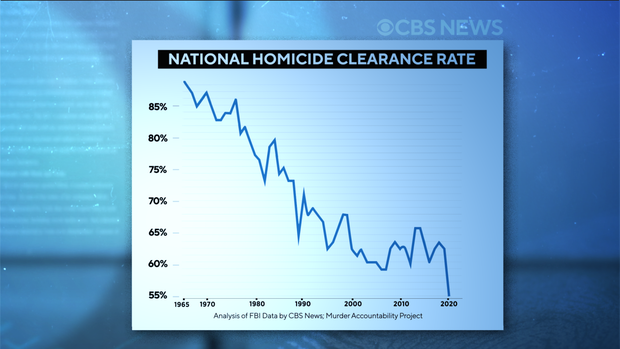
There are more unsolved murders nationwide, but Dallas Fort Worth may be less credible than them. There is
Dallas (CBSDFW.COM)- Five years after the murder of his son Even now, it happened what Bridget Williams was trying to connect.
"I'm proud of it because I can now talk about him without crying," she told CBS11.
Gradydan was on his way home in January 2017. , When another driver crashes into him, pulls a gun, and tries to rob him. Grady was shot by hitting gas. The Dallas Police Department found videos of other cars, but did not identify the shooter.
"No one has been tried. I don't know if people are looking into it anymore. Some sort of case has been sealed. It feels like it's packed somewhere. It's like that. I feel like I've forgotten it. "
According to the FBI, murder is the crime most likely to be resolved in the United States, but success rates have declined nationwide for years.

According to a CBS News Innovation Lab survey found in Texas law enforcement agencies, more than 70% of murders typically have a lower murder rate. It was cleared until 2016 when it started. By 2020, when the latest state data was available, it reached 53%.
It has proven more difficult to know how local police are behaving.
Fort Worth police reported clearing 72% of homicides in 2020, but FBI records show that clears are a bit less, 55%. Similarly, the Dallas Police Department reported clearing 78% of murders in 2020, but FBI records show that they are doing half that, 39%.

When asked, both departments claimed that their internal records were accurate, but CBS11 told the Dallas Police Department of their data. Pressure was put on to explain the serious contradiction. The department's intelligence department investigated and discovered errors in the reporting process. We are currently working to revise records in state and country databases to reflect a much higher success rate.
Lieutenant Stephen Bishop, who oversees data management, wrote in an email to CBS 11: "[We] are dedicated to reporting DPD crimes / arrests correctly. I didn't know the difference, I've never seen it, let alone why they happened."
The murderer clearance rate is an important indicator for assessing the effectiveness of police stations.
In a recent interview with former Dallas Police Department chief Lenny Hall, CBS News correspondent Jim Axelrod said, "In some departments, it's basically as good as the murder clearance rate. Does anyone know? "
"Most chiefs understand that," she replied.
The murder of her own father in her duties as a Detroit police officer was never resolved.
"I'm probably scared because of that today. I know what that means to me, so I understand what it means to others," Hall said. Said.
Professor Tim Bray of UT Dallas oversees data collection as a former Deputy Director of the Illinois Police Department and sees clearance rates as a valuable tool.
"There is a desire to know how Dallas is working on other cities. What do we do that these other cities are? Or what can they learn from us? "He said.
He said many factors can affect the success of the department.
"I want to know if the types of crimes have changed, if the level of personnel has changed, and if my detective training has declined over time," he said.
Chief Hall told CBS News that proper placement of murder units was difficult in departments like Dallas and lost officers earlier than they could hire.
"I came in with 600 fewer officers than my predecessor. It's the same challenge," she said.
In 2017, when she started, there were 28 murder detectives. At some point a year later, there were only 16 people. One of the many cases that had to be reassigned was that of Grady Dunn.
"It's not fair because every family has the right to know what happened," his mother said.
Bridget hasn't given up on getting an answer one day. She always takes her son and wears a necklace with his picture.
"I keep Brady alive. I keep his case deep in my heart," she said.
On every birthday or anniversary of her, she calls the police to check in and reminds them that their work is not done.
"I want to know that the murderer isn't walking around," she said. "It will close some of the holes in my heart right now."
Current leaders of both the Dallas Police Department and the Fort Worth Police Department rejected the request for an interview about the murder clearance rate. did. So the CBS News Innovation Lab digs into the data looking for answers and finds that if the victim is white, the murder is much more likely to be resolved.
The reason behind it is complicated. Adjust at 10 pm on Thursday night. You can know in detail.
Full coverage of "crime without punishment" and CBS News from CBS stations nationwide are availablehere

The CBS DFW team is a group of experienced journalists serving content on CBSDFW.com.
Thank you for reading CBS NEWS.
Create a free account or log in to
to take advantage of other features.


